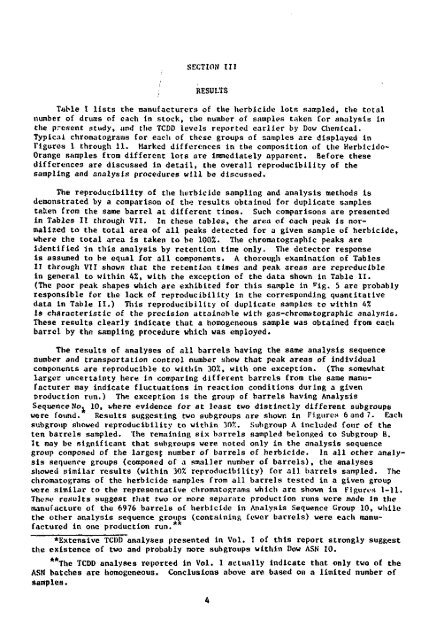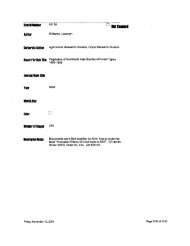Analytical Methodology for Herbicide Orange. Volume II - Special ...
Analytical Methodology for Herbicide Orange. Volume II - Special ...
Analytical Methodology for Herbicide Orange. Volume II - Special ...
Create successful ePaper yourself
Turn your PDF publications into a flip-book with our unique Google optimized e-Paper software.
SECTION <strong>II</strong>IRESULTSTable 1 lists the manufacturers of the herbicide lots sampled, the totalnumber of drums of each in stock, the number of samples taken <strong>for</strong> analysis inthe present study, and the TCDD levels reported earlier by Dow Chemical.Typical chromatograroa <strong>for</strong> each of these groups of samples are displayed inVigures 1 through 11. Harked differences in the composition of the <strong>Herbicide</strong>-<strong>Orange</strong> samples from different lots are immediately apparent. Be<strong>for</strong>e thesedifferences are discussed in detail, the overall reproducibility of thesampling and analysis procedures will be discussed.The reproducibility of the herbicide sampling and analysis methods isdemonstrated by a comparison of the results obtained <strong>for</strong> duplicate samplestaken from the same barrel at different times. Such comparisons are presentedin Tables 11 through V<strong>II</strong>. In these tables, the area of each peak is normalizedto the total area of all peaks detected <strong>for</strong> a given sample of herbicide,where the total area is taken to be 100%. The chromatographic peaks areidentified in this analysis by retention time only. The detector responseis assumed to be equal <strong>for</strong> all components. A thorough examination of Tables<strong>II</strong> through V<strong>II</strong> shows that the retention times and peak areas are reproduciblein general to within 4%, with the exception of the data shown in Table <strong>II</strong>.(The poor peak shapes which are exhibited <strong>for</strong> this sample in p ig. 5 are probablyresponsible <strong>for</strong> the lack of reproducibility in the corresponding quantitativedata in Table <strong>II</strong>.) This reproducibility of duplicate samples to within 4%is characteristic of the precision attainable with gas-chromatographic analysis.These results clearly indicate that a homogeneous sample was obtained from eachbarrel by the sampling procedure which was employed.The results of analyses of all barrels having the same analysis sequencenumber and transportation control number show that peak areas of individualcomponents are reproducible to within 30%, with one exception. (The somewhatlarger uncertainty here in comparing different barrels from the same manufacturermay indicate fluctuations in reaction conditions during a givenproduction run.) The exception is the group of barrels having AnalysisSequence No. 10, where evidence <strong>for</strong> at least two distinctly different subgroupswere found. Results suggesting two subgroups are shown in Figures 6 and 7. Eachsubgroup showed reproducibility to within 30%. Subgroup A included four of theten barrels sampled. The remaining six barrels sampled belonged to Subgroup B.It may be significant that subgroups were noted only in the analysis sequencegroup composed of the largest number of barrels of herbicide. In all other analysissequence groups (composed of a smaller number of barrels), the analysesshowed similar results (within 30% reproducibility) <strong>for</strong> all barrels sampled. Thechromatograms of the herbicide samples from all barrels tested in a given groupwere similar to the representative chromatograms which are shown in Flgurt-s 1-11.These results suggest that two or more separate production runs were made in themanufacture of the 6976 barrels of herbicide in Analysis Sequence Group 10, whilethe other analysis sequence groups (containing fewer barrels) were each manufacturedin one production run.**Extensive TCDD analyses presented in Vol. I of this report strongly suggestthe existence of two and probably more subgroups within Dow ASN 10.**The TCDD analyses reported in Vol. I actually indicate that only two of theASN batches are homogeneous. Conclusions above are based on a limited number ofsamples.
















